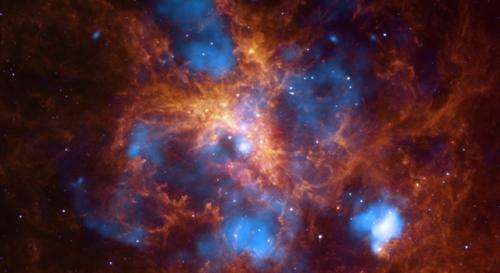The star-forming region, 30 Doradus, is one of the largest located close to the Milky Way and is found in the neighboring galaxy Large Magellanic Cloud. About 2,400 massive stars in the center of 30 Doradus, also known as the Tarantula Nebula, are producing intense radiation and powerful winds as they blow off material. Image credit: X-ray: NASA/CXC/PSU/L. Townsley et al.; Infrared: NASA/JPL/PSU/L. Townsley et al.
(PhysOrg.com) -- This spiderweb-like tangle of gas and dust is a star-forming region called 30 Doradus. It is one of the largest such regions located close to the Milky Way galaxy, and is found in the neighboring galaxy Large Magellanic Cloud.
About 2,400 massive stars in the center of 30 Doradus, also known as the Tarantula nebula, are producing intense radiation and powerful winds as they blow off material.
Multimillion-degree gas detected in X-rays (blue) by NASA's Chandra X-ray Observatory comes from shock fronts -- similar to sonic booms -- formed by these stellar winds and by supernova explosions. This hot gas carves out gigantic bubbles in the surrounding cooler gas and dust shown here in infrared light from NASA's Spitzer Space Telescope (orange).
Provided by JPL/NASA























